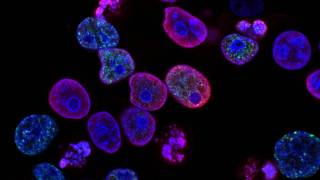Zika Could Treat Brain Cancer

Numerous research studies have previously revealed that the Zika virus causes brain defects, such as Microcephaly, in unborn children.
An interesting new study reports that the Zika virus could eventually be used to kill cancer cells in the brain.
These researchers found that the Zika virus preferentially infected and killed patient-derived, glioblastoma stem cells.
Just like healthy tissues, the growth of glioblastomas is driven by stem cells that proliferate and give rise to other tumor cells.
Glioblastoma stem cells are hard to kill because they can avoid the body's immune system, and are resistant to chemotherapy and radiation.
"It is so frustrating to treat a patient, only to see his or her tumor recur a few months later. We wondered whether nature could provide a weapon to target the cells most likely responsible for this return," says Michael S. Diamond, MD from Washington University School of Medicine in St. Louis
These researchers believe an innovative approach to killing cancer stem cells involves using viruses that specifically target tumor cells.
The Zika virus appears to disrupt fetal brain development by preferentially targeting neural stem and progenitor cells. The virus' effects on adult brains--which contain fewer active stem cells that developing fetal brains--are generally much less severe.
These researchers tested a mutant strain of Zika that is less virulent than naturally occurring strains of the virus.
This "attenuated" strain, which is more sensitive to the body's immune response, was still able to specifically target and kill glioblastoma stem cells.
Additionally, this process was even more effective when combined with a chemotherapy drug, temozolomide, that usually has little effect on these cells.
"This effort represents the creative synthesis of three research groups with complementary expertise to attack a deadly cancer by harnessing the cause of another disease," says Dr. Diamond.
"Adults with Zika may suffer less damage from their infection, suggesting that this approach could be used with acceptable toxicity."
"Our study is a first step towards the development of safe and effective strains of Zika virus that could become important tools in neuro-oncology and the treatment of glioblastoma," says Dr. Diamond.
"However, public health concerns will need to be addressed through pre-clinical testing and evaluations of the strains' ability to disseminate or revert to more virulent forms."
Glioblastoma is an aggressive type of cancer that can occur in the brain or spinal cord. Glioblastoma forms from cells called astrocytes that support nerve cells. Glioblastoma can occur at any age, but tends to occur more often in older adults. It can cause worsening headaches, nausea, vomiting and seizures.
Glioblastoma, also known as glioblastoma multiforme, can be very difficult to treat and a cure is often not possible. Traditional treatments may slow progression of the cancer and reduce signs and symptoms.
This study was published in The Journal of Experimental Medicine, researchers were from Washington University School of Medicine in St. Louis and the University of California, San Diego.
The Journal of Experimental Medicine (JEM) features peer-reviewed research on immunology, cancer biology, stem cell biology, microbial pathogenesis, vascular biology, and neurobiology.
Our Trust Standards: Medical Advisory Committee

























